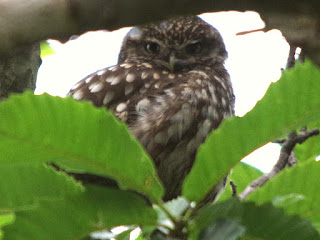Here is a close view of the Great Crested Grebes' nest on the Serpentine island, thanks to the kind people at Bluebird Boats who took me out in a motor boat to get the picture.
And this is the solitary Coot chick from the absurdly situated nest on the boat platform.
Mateusz told me that he had rescued this chick more than once when it had wandered off into danger. He also said that he had tried last year to help the Coots nesting in the small boathouse by putting it in a plank to allow the chicks to climb up on to the platform when they fell into the water. But they refused to use it, and he had had to rescue them with a net. We agreed that Coots aren't very bright.
But they are certainly persistent. The pair nesting on the edge of the weir at the Serpentine outflow, who had lost all their eggs, have laid another two. There is a plank here so that if any chicks hatch and fall down the weir they can climb up again, but it doesn't seem to make any difference to the zero per cent survival rate from this nest over the years.
Female ducks are emerging from purdah after the nesting season, from which just two young Mallards have survived. No Mandarins have made it, and I didn't even see any Red Crested Pochard ducklings, although they have occasionally succeeded in past years. Here are two female Mandarins at Peter Pan ...
... and two female Red Crested Pochards having a mild disagreement at the Serpentine island.
The eldest Canada gosling is now growing its black-and-white adult face.
A Hobby was visible in a plane tree near the Speke obelisk.
And the male Little Owl was in his usual chestnut tree despite the morning rain.
This beautiful Comma butterfly was in the reed bed at the southeast corner of the Serpentine.









Dear Ralph, Many thanks for the introduction to the hobbies today. I waited for forty minutes and was eventually rewarded, with the male (I think) coming back with something that looked quite large, brown and furry. Do they take small mammals, or perhaps it was a bird? The female flew up from the nest, got some food from the male and then took it back, and then the male sat around for a while in the place that you mentioned. It was an absolute thrill. Thank you! Jason
ReplyDeleteVery glad you got to see the Hobbies. They mostly eat dragonflies and small birds such as Swifts, Swallows and House Martins, which this fast, agile raptor can catch. Our park hobbies have been seen eating Rose-Ringed Parakeets too. I've not heard of them eating mammals other than bats, though they do take small reptiles. I'm guessing that the prey was a bird. Could it have been a Starling?
DeleteI saw the bad Egytian Goose parents in the Long Water today. They only have 2 young now and they were steering them rather too close to a heron
ReplyDeleteYes, they have no sense at all, and I fear that the remaining two will go the way of the others. But, for better or worse, their genes will live on in the form of the young bird that was adopted by the family on the Serpentine.
Delete